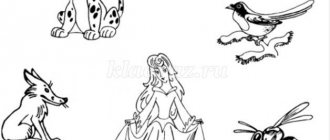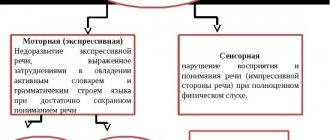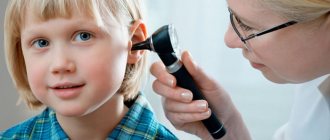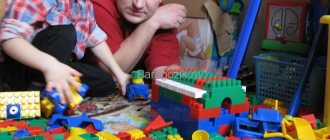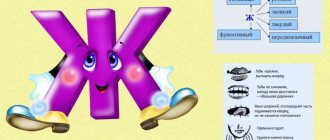A child with motor alalia has a high level of non-verbal intelligence (he understands everything), verbal intelligence is in its infancy (he does not speak or speaks little and poorly) and high emotionality (recently, some scientists have identified this as a separate type - emotional intelligence). Such a child, in most cases, from one and a half to three years of age is very kind, affectionate, and sociable, and after four, when he realizes that he is different from his peers, he becomes withdrawn, shy or aggressive.
I am engaged in the formation of verbal intelligence (speech) through intact understanding, logic and emotions. In correctional pedagogy there is such a principle - working through intact analyzers, for example, when working with sensory alalia, they immediately begin to teach reading in order to form an understanding of “sound”, audible speech through the intact visual analyzer.
Emotions: in an integrated approach, I indicated several ways that affect emotions to increase a child’s motivation, which are more effective than for children with mental retardation and sensory alalia.
I start work with the first words and lexical topics that are emotionally significant for the child. Every child has his favorite toys: some play with cars, some with “little animals”; girls prefer dolls and ponies. Therefore, it is worth asking the parents about the child’s preferences and building the first lessons on their basis: firstly, the child will make contact faster, and secondly, perhaps in his topic he already has some words or onomatopoeia with which he can communicate , and thirdly, by typing words on this topic, the child will be able to immediately include them in his play and life, he will more actively use and consolidate them.
History. Boy, 4.5 years old, motor alalia, in the active dictionary - mother, woman, give, several onomatopoeias. His passion was trams and trains. We drew them, built them from cubes, rolled them... The first word called up was the word “coupling” - connecting the cars to each other. (It turns out that he was interested not so much in trains as in the way the cars were connected). Then came a very quick set of vocabulary: driving, buzzing, carriage, train, road….
Logic: the difference between understanding speech and active speech in motor alalitics has its own characteristics. At first, such children are confused with children with developmental disabilities or considered simply lazy (“he doesn’t want to talk”). Recalling the first words through simple repetition does not work (as it does with ZRR and SA). Often, even after “talking,” a child with MA can repeat words or phrases after the speech therapist, but he does not use them independently in speech or in life. In order to form independent speech, we work:
— through questions (with SA we explain and repeat 80% of the time and ask 20% of the time, and with MA it’s the other way around)
- a large number of repetitions both when calling out words, and when forming phrases, and when working with cases in the future occurs due to the use of a large number of situations where the use of this word, case, etc. is required, and not just repetition of the same thing
Alalia motor. Speech therapy classes, work with children with alalia.
A child with motor alalia has a high level of non-verbal intelligence (he understands everything), verbal intelligence is in its infancy (he does not speak or speaks little and poorly) and high emotionality (recently, some scientists have identified this as a separate type - emotional intelligence). Such a child, in most cases, from one and a half to three years of age is very kind, affectionate, and sociable, and after four, when he realizes that he is different from his peers, he becomes withdrawn, shy or aggressive.
I am engaged in the formation of verbal intelligence (speech) through intact understanding, logic and emotions. In correctional pedagogy there is such a principle - working through intact analyzers, for example, when working with sensory alalia, they immediately begin to teach reading in order to form an understanding of “sound”, audible speech through the intact visual analyzer.
Emotions: in an integrated approach, I indicated several ways that affect emotions to increase a child’s motivation, which are more effective than for children with mental retardation and sensory alalia.
I start work with the first words and lexical topics that are emotionally significant for the child. Every child has his favorite toys: some play with cars, some with “little animals”; girls prefer dolls and ponies. Therefore, it is worth asking the parents about the child’s preferences and building the first lessons on their basis: firstly, the child will make contact faster, and secondly, perhaps in his topic he already has some words or onomatopoeia with which he can communicate , and thirdly, by typing words on this topic, the child will be able to immediately include them in his play and life, he will more actively use and consolidate them.
History. Boy, 4.5 years old, motor alalia, in the active dictionary - mother, woman, give, several onomatopoeias. His passion was trams and trains. We drew them, built them from cubes, rolled them... The first word called up was the word “coupling” - connecting the cars to each other. (It turns out that he was interested not so much in trains as in the way the cars were connected). Then came a very quick set of vocabulary: driving, buzzing, carriage, train, road….
Logic: the difference between understanding speech and active speech in motor alalitics has its own characteristics. At first, such children are confused with children with developmental disabilities or considered simply lazy (“he doesn’t want to talk”). Recalling the first words through simple repetition does not work (as it does with ZRR and SA). Often, even after “talking,” a child with MA can repeat words or phrases after the speech therapist, but he does not use them independently in speech or in life. In order to form independent speech, we work:
— through questions (with SA we explain and repeat 80% of the time and ask 20% of the time, and with MA it’s the other way around)
- a large number of repetitions both when calling out words, and when forming phrases, and when working with cases in the future occurs due to the use of a large number of situations where the use of this word, case, etc. is required, and not just repetition of the same thing
Symptoms of sensory alalia
The sensory alalik is not at all silent. Children have active—sometimes even overly—expressive speech. However, at the same time, they are absolutely not critical of their statements, not understanding themselves what exactly they are saying.
Characteristic features of sensory alalia:
- The mindless repetition of frequently heard phrases is echolalia. The child may persistently repeat advertising slogans, words of cartoon characters, etc. Sometimes speech may seem meaningful if the child repeats the last word he heard along with the answer. But if you change the phrase, there will be no result.
- Frequent confusion of words, syllables and phrases, the use of made-up words - the so-called logorrhea - is another characteristic symptom of sensory alalia.
- In most cases (about 70%), hearing remains intact. However, there is instability of auditory attention. In addition, many alaliks suffer from hyperacusis - increased sensitivity to certain sounds.
- Phonemic speech perception is impaired. That is, the chain through which auditory excitation is transmitted to brain structures associated with speech “does not work” in the child.
- There are also some memory impairments. In order to remember a word or phrase, alalik requires quite a lot of repetition.
So, speech with sensory alalia is absent not because the child has disorders of the auditory or speech or articulatory apparatus, but due to the inability to form a connection between the sound of a word and an object.
Progress of the lesson:
I.
Introductory part:
1. Organizational point:
Time for business, time for fun. Listen to my story. I’ll sit up straight, I won’t bend, I’ll get to work! Check, my friend, are you ready to start the lesson? 2. Announcement of the topic and purpose of the lesson:
The topic of our lesson is “Dishes”. Let's get acquainted with the dishes.
II. Main part:
1. Game “sly spoon”.
Place utensils in front of the child: a plate (faience), a spoon (metal), a cup (glass) - and name each item. Ask the child to show objects and ask: “What is this?”
We will play with a spoon, tap the spoon on the plate: And name the dishes. "This is a plate." Knock with spoon
Close your eyes, take a cup.
Guess why the spoon is knocking? The child closes his eyes and listens to sounds.
Shows the dishes that were knocked on. Trying to give names to the dishes. (Loka, taka, cha-chaka)
2. Game "What is this."
The speech therapist invites the child to examine and show, then name the dishes (as best he can, without paying attention to articulation)
Items: teapot, cup, spoon, knife, plate. “I will... drink from a cup.” (child repeats: pp-pi)
“I’ll... eat from the plate (yum).” “I will use a knife...?” (cut-rr eat)
3. Physical exercise.
“Get up, let’s rest!”
I take the cup in my hands,
And I bring it to my mouth,
I tilt my head (performs the movements behind the speech therapist, independently)
I drink the tea to the bottom.
Well done. Sit down.
4. Game “Assignment”.
The child is standing at the table. Speech therapist: “Take a cup.” “What did you take? "
- cup. (chaku)
- "What did you do?" (took and dropped)
So continue with each of the dishes.
III.
Final part.
- Activity assessment: You were active in class. Well done, keep trying.
- Summing up: What dishes did you learn today? (child answers).
- Homework: written in an individual notebook: (play with dishes, learn to name each type)
Summary of an individual speech therapy session with a 4-year-old child.
Topic: "Wild Animals".
Purpose: to cause onomatopoeia;
Tasks:
- develop auditory attention,
- further development of the thoraco-abdominal type of breathing,
- activate vocabulary on the topic,
- develop fine motor skills and constructive praxis.
Equipment: toys or pictures with wild animals, cut-out pictures on the topic.
Diagnosis of motor alalia in children
The examination is carried out with the participation of several specialists. The medical part of pathology is dealt with by a neurologist, otolaryngologist, and pediatrician. Consultation with a speech therapist and psychologist is required. At this stage, specialists are faced with the task of making an accurate diagnosis, identifying the degree of impairment, and excluding other speech disorders.
Diagnostics include:
- Medical examination - history taking, examination of a small patient. Any details are important: how the mother’s pregnancy and childbirth proceeded, how the newborn period progressed, features of physical and neuropsychic development. A neurologist identifies problems with motor skills, poor coordination of movements, uneven reflexes, decreased or increased muscle tone. Electroencephalography, Doppler examination of cerebral vessels, and MRI help determine the diagnosis and cause of the disorders;
- A speech therapy examination consists of assessing speech and its levels of development. The specialist uses tests to determine the volume of vocabulary, level of speech development, grammar, syllable structure and other indicators. The movements of the lips and tongue, the accuracy of these movements, and articulatory switches are assessed;
- Psychological examination - assessment of the emotional-volitional sphere and cognitive abilities by a psychologist. For motor alalia in preschoolers, testing is carried out in the form of games so that the child can fully open up and the specialist can actively monitor the patient’s behavior, simulating various situations.
Having received complete information about the patient, specialists determine treatment tactics and prognosis.
Correction of sensory alalia
Classes to correct this condition are structured depending on its severity. A severe form of alalia, resulting from significant damage to areas of the brain, the child is completely unable to analyze sounds and, accordingly, understand the surrounding speech. A lighter state allows children to be aware of individual words, but not to isolate them in phrasal speech or, conversely, to perceive situationally remembered sentences and not understand words used independently.
To correct sensory alalia, a speech therapist must conduct an examination to correctly determine the severity of the condition and build a lesson plan that includes the necessary exercises and tasks.
Severe forms of this condition can lead to secondary mental and intellectual development disorders, so it is important to find a specialist who will help the child develop his speech.
Treatment of motor alalia in children
The therapy is complex, aimed at eliminating the cause of the disease, correcting disorders, influencing the sensory, intellectual, emotional and volitional sphere. A psychologist/neuropsychologist, a neurologist, and a speech therapist/speech pathologist work with the patient.
It is advisable that treatment of motor alalia, regardless of the symptoms, be started as early as possible. The optimal period is 3–4 years. Preschoolers are easy to correct; moreover, no violations were recorded at this age. Another important condition is the regularity of the exercises.
The medical part of the correction consists of drug therapy, physiotherapy, and massage. These procedures eliminate brain disorders, restore blood flow in blood vessels, and improve motor function.
Psychological treatment for signs of motor alalia in children is aimed at improving memory, attention, thinking, and control of the emotional-volitional sphere.

